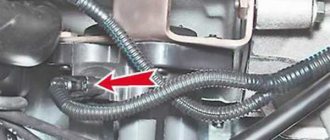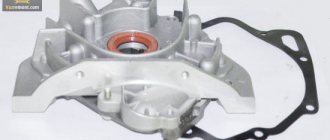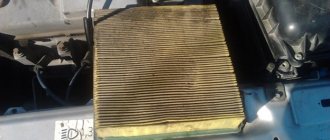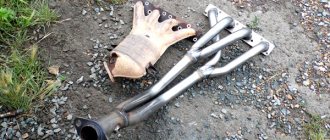Agree, cars that have a dual exhaust system always look very presentable and can indicate the sporting qualities of this vehicle. But what to do if you are the owner of a completely standard, popular VAZ car? The answer is obvious - install a double exhaust on the VAZ 2114.
Today we will look at the pros and cons, and directly touch on the replacement process itself.
Replacing a return flow muffler with a direct flow one with your own hands
When manufacturing a direct flow, it is advisable to use the positive properties of several types of structures.
Reasons for replacing a standard muffler with a direct-flow muffler
Car owners change the factory muffler to a direct flow one for several reasons:
- obtaining an increase in engine power;
- subjective improvement of acoustic parameters of the exhaust;
- increasing the aesthetic parameters of the car;
- complete modernization of the exhaust channel;
- The installed muffler has failed.
Tools and materials for work
A direct-flow muffler is often purchased, but for lovers of tools and an insatiable thirst for creativity, we recommend making it yourself. It is preferable to make parts from stainless steel with a thickness of 0.8–2.0 mm. Select ferrous metal blanks with a thickness of 1.0–1.5 mm for the case, the rest 2.0–4.0 mm to avoid premature burnout of parts, and also use standard blanks. For the body, use a suitable size: a fire extinguisher, a thermos, an empty gas or scuba cylinder.
To fill the muffler chamber, non-flammable porous material or a combination of them is used:
- basalt or other mineral wool;
- fine mesh metal mesh;
- metal mesh for the kitchen;
- metal shavings.
Tools:
- angle grinder (grinder);
- drill or drilling machine;
- welding machine;
- consumables: metal discs for grinders, drills, electrodes, etc.
Reworking an old muffler
We dismantle the old muffler, disassemble it using a grinder, leaving the body parts and the inlet pipe. While preserving the partitions, we drill holes in them for the passage of exhaust gases. The cameras further reduce exhaust volume.
We cut out everything that is not needed from the old muffler
We perforate the inner pipe in an accessible way. The diameter of the perforated pipe is equal to the diameter of the inlet pipe or more up to 30%.
a small number of small holes will help preserve the rich bass rumble from the engine when exhausting
Keep in mind that mineral wool fibers will be “blown out” of the chamber faster through large holes and grooves.
Stainless steel helps to increase the service life of parts and mechanisms several times
In the future, the diameter of the inner pipe can be reduced by simple manipulations, but increasing it is disproportionately more difficult.
cut the length of the pipe to the required size
We put metal mesh for the kitchen in place of the perforation of the pipe.
cover the internal perforation with fine-porous non-flammable material
Wrap the kitchen mesh tightly with metal mesh in 1-3 layers. We fix the mesh with annealed steel wire with multiple twists or crimp it with several clamps.
We enhance perforation, reducing its permeability to mineral wool
We coordinate and clean the welding points, weld the perforated pipe into its regular place.
We carry out welding in compliance with all safety rules
We fill all free space inside the muffler tightly with the selected filler.
the presence of several chambers contributes to greater functionality of the muffler
Working with mineral wool requires personal protective equipment.
the absence of a metal mesh between the holes and the wool will lead to a faster “blowing” of the wool out of the muffler
- We grab the edge of the “lid” of the body with two or three tacks to avoid displacement and weld the body.
- To protect against corrosion and give it an aesthetic appearance, we paint it with heat-resistant paint in your favorite color.
- We install it on the car. We start the engine. We rejoice!
- To make the muffler last longer, we drill one or more holes with a diameter of 1.5–2.0 mm in the housing to drain condensate. To determine the lowest point, the car must be horizontal.
Dual Exhaust Installation Steps
- First of all, you need to remove the old muffler.
- Afterwards, you should hang the right part of the new muffler on the right side of the car (previously placed on a lift), while using the existing cushions. In this case, the left part does not need to be fastened; you just need to connect the muffler to the resonator using a clamp and seals.
- Next, you need to connect the left part of the muffler to the main part through the pipes. In this case, it is necessary to take into account the location of the fastening rod, and it is also necessary to calculate the place where the holders in the form of brackets will be placed.
- It is necessary to use a drill to make two holes with a diameter of 1.5 mm in the spar. These holes can attach a holder, which is screwed with self-tapping screws.
- The completed operations allow you to move on to attaching the main left part. Fastening is carried out by inserting the muffler cushion directly into the bracket-shaped holder; the exhaust rod is also inserted into the cushion.
- The opposite side of the muffler is secured using O-ring clamps. This fastening should not be too tight.
- All the work done allows us to move on to the process of adjusting and establishing symmetry between the two exhaust pipe tips. Initially, loosely tightening the connections will allow the installation to be fine-tuned.
Replacement
If you realize that the muffler has already served its purpose and needs to be replaced, be sure to carry out a number of preparatory measures.
Paying attention to the signs of breakdown that appear, check what exactly the fault is and where it occurred. Buy a new device to replace the old one. Be sure to make sure in the store that you bought a genuine product and not a fake. Buy new mounting pads made of rubber
Even if the old ones are in satisfactory condition. Under the influence of temperature and exhaust gases, rubber cushions quickly lose their characteristics. Therefore, it is not worth taking risks. Additionally, buy a metalgraphite ring. It is mounted at the place where the muffler pipe is connected, directly under the clamp. This is done to ensure better tightness. Having a complete repair kit is a very useful thing.
The preparation is complete, so you can start dismantling the old one and installing the new one:
- Place the car in the pit;
- Prepare for dismantling the clamp that connects the resonator and the muffler pipe. To do this, the two mounting bolts are cleaned with a wire brush, and the nuts are treated with the almighty WD40. If you don't have it, get some brake fluid or a rust remover. This is a problem area that makes removal difficult;
- Using two 13mm wrenches, remove the two nuts that hold the clamp;
- If all the manipulations carried out did not produce results, the fasteners will have to be cut off with a grinder. It is not difficult. Replace the clamp with a new one, of course;
- After dismantling the clamp, remove the o-ring made of metal;
- Disconnect the muffler pipe from the resonator;
- Now you can easily remove the muffler itself;
- Installation of a new exhaust system element is carried out in the reverse order;
- Be sure to lubricate the gasket ring. Moreover, it must be a special sealant for exhaust gases. This way the tightness of the connection will be at the maximum level.
Material
What material is the rear muffler of the VAZ-2114 made of? As a standard, it is made of sheet metal. The technology is very old and has a number of disadvantages. First of all, it is low resistance to corrosion. In this regard, manufacturers coat the metal with aluminum-coated paint. But as practice shows, this is ineffective.
As for non-standard mufflers (these are direct flow), they are made of stainless steel. This is a more expensive, but very corrosion-resistant material. As practice shows, stainless steel perfectly “digests” our road salt and winters. The only thing is that over time, bitumen and other “joys” of Russian roads stick to it. The stainless steel muffler installed on the VAZ-2114 will last a very long time. But the trouble is that only sports direct-flow tubes are made from such material. They are characterized by high operating noise because they do not have any partitions. The design provides for the presence of a straight perforated pipe, on the reverse side of which glass wool is pressed. Because of this, gases escape directly into the atmosphere. Yes, it will become easier for the engine to “breathe”, but the sounds are not neutralized in any way. Therefore, forward flow is not suitable for a comfortable ride. The only way out is to install an attachment on the VAZ-2114 muffler. This will significantly improve the appearance of the car.
How to repair a “glushak” with your own hands
The muffler on the “fourteenth” and “fifteenth” is considered one of the most vulnerable points of the car. The fact is that due to exposure to high temperatures, the metal quickly burns out, that is, the tightness of the system is broken. Therefore, the part must be changed as soon as there is a suspicion that it is not working.
Reasons for failure
Most often, mufflers “burn out” - that is, due to hot exhaust, the metal inside the housing begins to thin out, which ultimately leads to the appearance of holes. However, this is not the only reason why the silencer may fail:
using a homemade device - handicraft products do not differ in quality and long service life;
mechanical shocks from uneven roads - dents and deformations of the pipe also lead to loss of tightness;
Rust and corrosion sooner or later affects even the highest quality original mufflers.
In general, all of the above factors influence service life to some extent. The car owner can easily identify all of the above faults - just drive the VAZ into the inspection hole and visually examine the muffler. In addition, when deformations, burnouts and corrosion reach their “peak”, the part will begin to make characteristic sounds when moving - gurgling, sharp pops, knocking.
Types of mufflers and their differences
There are 4 types of mufflers based on the method of absorbing acoustic waves:
- reflective;
- restrictive;
- absorption;
- resonator.
By design:
- straight-through;
- reverse flow
The reflective circuit is reverse-flow, the rest are direct-flow.
Reflective
If one muffler is installed in a car, then a reflective version is used. It uses the principle of “breaking” the flow of exhaust gases by creating several partitions, expansion chambers and turns. Exhaust volume is reduced to standard levels. For this reason, the vast majority of factory vehicles are equipped with the reflective type.
most popular for factory vehicle configuration
The disadvantage of this type of muffler is the reduction in engine power due to the resistance of the exhaust system to the flow of exhaust gases.
Resonator
A resonator muffler is installed as the first stage in the exhaust system of powerful engines. It consists of a perforated pipe placed in a housing. The body is divided into two or three sections. The energy of the exhaust gases is weakened due to a stepwise reduction in pressure.
installed as the first stage of exhaust energy suppression
The part reduces the force of sound vibrations and maintains engine power with a free flow of exhaust gases.
Restrictive
In restrictive mufflers, the gas flow passes through a diaphragm or cone narrowing, which leads to a decrease in engine power. The acoustic protection of such devices is low, since the diaphragm does not interfere with the rectilinear movement of the sound wave.
Absorption
The damping function for sound vibrations in the absorption muffler is performed by a finely porous non-flammable material located in the space between the perforated pipe and the housing. The design is similar to the resonator type. This type has little effect on power reduction.
Damper installation
The damper is installed either before or after the muffler. The volume of the forward exhaust will be clearly reduced only when the damper is completely closed. Technological clearances of 3-5% remain for the passage of exhaust gases - so the engine does not stall. In this regard, engine power is significantly reduced due to blockage of the exhaust system.
the damper is made by hand
A damper is also used to switch from a direct-flow to a return-flow muffler and vice versa, if necessary. In this case, a new muffler is installed parallel to the old one, and the damper is mounted in front of them. This scheme is already used on some brands of cars from the factory.
mechanical adjustment of the damper is carried out on the move by the driver from the cab
You can drive a short distance with the throttle closed, but driving constantly is unacceptable for the engine.
the damper is installed in front of the muffler
Silencer - purpose, device, operation
An important element of the exhaust system is the muffler; operating a car without it is impossible. As a rule, the muffler is located at the rear of the vehicle and, in conjunction with the exhaust system, serves to remove harmful gases from the engine, bypassing the vehicle interior.
Car mufflers are made from stainless, aluminized and regular black steel. Stainless steel “silencers” are practically not available for sale due to their high cost and long service life (their service life is 10–15 years). Aluminized mufflers are installed on VAZ 2114/2115. They are common in the domestic and European markets (service life 3–7 years). Regular black steel mufflers are cheap substitutes and last only a few months, so are rarely used.
What is a “glushak” for?
Main functions of the muffler:
- reduction of noise during fuel processing;
- reduction in the rate of gas release and their temperature.
The muffler is attached with special rubber pads to curved metal hooks, softening vibrations from the car exhaust
All elements of the exhaust system are exposed to high temperatures, so the coating (anti-corrosion paint, mastic) that is applied to the muffler burns out. The exhaust system of the VAZ 2114/2115 is mounted under the body on the bottom of the car.
The resonator is an important part of the exhaust system; it directly affects engine power. The faster the exhaust gas is removed from the resonator, the faster and more power the car develops.
The design of the pipe consists of all the necessary elements, therefore, when exhausted, the exhaust gas is correctly distributed throughout the exhaust pipe
The muffler on the VAZ 2114/2115 is attached to the bottom of the car with special rubber bands, clinging to flat hooks on the side and top. Why is an elastic band used, and, say, not a metal fastener?
For the VAZ 2114/2115, the muffler is a volumetric sealed metal chamber, divided inside by various partitions. The entire exhaust gas flow passes through the muffler sections and is finally extinguished and cleaned. If you look at the muffler diagram, it will look almost the same on all cars.
The principle of removing exhaust gases from a car muffler
Muffler mount
The muffler hangs on the car using the muffler suspension cushion (5), and the components of the muffler are connected to each other by gaskets, O-rings, and clamps.
VAZ cars of the 14th and 15th models are still in demand among Russian drivers today. The machines are easy to use, do not require vigilant attention and rarely require repairs. However, they also have a “sore spot” - the mufflers. Therefore, VAZ 2114/2115 owners need to be prepared for the fact that sooner or later they will have to repair or replace the silencer on their car.
Making and installing a flute
The flute (silencer) has more preferable characteristics. It dampens the exhaust pipe clearance much less than a damper. You can buy a flute, knowing the internal diameter of the outlet pipe, or make it yourself. Various silencer designs are shown in the photo.
factory models
Flute mounting options
Possible versions of the flute.
External - for outlet pipe diameters up to 50–60 mm.
method of attaching a flute to a small diameter exhaust pipe
Internal - for large diameters. The diameter of the smaller pipe should be 15–40% smaller than the diameter of the outlet pipe, the length should be from 0.25–0.35 m to 0.50–0.75 m. As a rule, unloading holes are made in it.
a properly designed flute “helps” you ride more quietly
To improve sound insulation of the exhaust, it is possible to wrap the flute with mineral wool. We protect it from blowing out around the perimeter with a fine metal mesh, as we did on a direct-flow muffler. In this case, the loss of engine power will be more noticeable, but the engine will operate more stable than with the throttle closed.
the sound becomes “more pleasant” to the ears of the traffic inspector
Tools and materials for making a flute
Required tools:
- Bulgarian;
- electric drill;
- welding machine;
- spanners.
It is better to choose blanks from stainless steel with a thickness of 0.8–1.2 mm, which guarantees long service life. Blanks made of “ferrous” metals are acceptable with a thickness of 2.0–2.5 mm or less if we plan to use the flute for short periods. As blanks we use two pieces of pipe and sheet metal for the flange.
Making a flute with your own hands
The order of work performed:
- We adjust all parts to the required dimensions. We measure the dimensions of the flange and larger pipe “on site”.
- We drill holes.
the notch divides the gas exhaust into two streams, which reduces the exhaust volume
To further relieve the exhaust system from excess exhaust gas pressure, holes are drilled in the flange.
additional holes allow for a freer exhaust
- We clean it and prepare it for welding.
- We weld the parts ourselves or with the help of a welder and clean the seams.
the flow of exhaust gases is suppressed due to unloading holes and counterflow
To protect against corrosion, we paint the flute with heat-resistant paint.
There is no need to paint stainless steel
We mount the flute on the exhaust pipe and enjoy the sound.
Videos about the muffler
There are many videos on the Internet in which the authors inventively and simply demonstrate how to make a direct flow with their own hands.
Video: how to make a straight-through muffler with your own hands
Another clear example of making a muffler from scratch. The straight-through version is made of stainless steel with two exhaust pipes.
Video: how to make a straight-through muffler from stainless steel
https://www.youtube.com/watch?v=zhxpX0O7E8s
Reasons for part failure
The muffler is affected by several different factors that can lead to failure, these are:
- Atmospheric precipitation, dirt. Precipitation means the occurrence of rain and snow. A mass that periodically falls on a hot pipe causes temperature changes, destroying the strength of the metal. Unfortunately, it will not be possible to protect the muffler in any way; moisture will in any case affect the metal. A smart solution would be to avoid driving through deep puddles and drive slowly on contaminated sections of the road. If the muffler and pipe are dirty, it is necessary to clean it with water (you can use a pressure jet from a hose). After cleaning, it is recommended to start the engine so that any water that has entered the muffler evaporates.
- Condensate. When the unit is idle for a long time, condensation forms in the muffler, causing a corrosive process. This leads to inevitable destruction of the internal parts of the muffler. This happens extremely rarely, but before the trip it is recommended to increase the operating speed by pressing the accelerator several times. The flow of exhaust gases removes moisture from the silencer.
- Chemical influence. As a result of the release of exhaust gas, a lot of toxic chemical particles settle on the walls of the muffler, destroying the metal, and allowing road reagents to get into the muffler.
- Physical influence. Hitting stones and blows from the muffler when driving on roads also lead to a lot of damage.
The chemical and physical effect on the muffler metal is a natural process
It will not be possible to disassemble and clean the muffler, since the container cannot be opened, and only the attention and professionalism of the driver on the road will help protect it from impacts and stones. Diagnosing and eliminating minor damage at the initial stage will help to avoid serious problems in the future.
The influence of various negative factors can lead to damage to the corrugation or other parts of the muffler
Extraneous sounds in the jammer
The causes of various noises and knocks in the muffler can be:
- Fastening the muffler to wire or ties. You should not wrap the muffler on a wire, otherwise rattling and knocking will occur. Use only rubber cushions.
- Foreign objects entering through the exhaust pipe. When driving over rough terrain, deep puddles, or driving in reverse, you should not forget that the exhaust pipe is literally 20 cm from the road surface, which means that various masses and stones can be thrown into the muffler. They often knock and rattle.
- Peeling of burnt metal inside the muffler. As a result of chemical exposure, a layer of soot forms on the walls of the silencer. For this reason, over the years, rattling noises can be heard inside the muffler due to peeling metal.
- Condensation also affects the exhaust sound. Condensation forms as a result of prolonged idling while the engine warms up. Ringing and gurgling are signs of accumulated moisture in the muffler. By increasing the speed several times, the condensate comes out and the signs of the malfunction disappear.
These points are possible factors influencing the exhaust sound of a muffler and are considered the most common.
Repairing and replacing the muffler on a VAZ 2114/2115 is available to every car enthusiast; the only question is confidence and time. It is easy to replace an old part with a new one if you have the tools at hand, but it is recommended to entrust the troubleshooting of the muffler to professionals. Any auto repair shop does this type of work. For little money and a short period of time, your muffler will be repaired. Remember, prevention is a reliable method of treatment!
Noise standards and liability for exceeding them
Responsibility for loud exhaust from a muffler is provided for under Article 8.23 of the Code of Administrative Offenses. The driver is charged for operating a vehicle with excess noise levels in accordance with the Technical Regulations of the Customs Union 018/2011 “On the safety of wheeled vehicles”, paragraph 9.9.
Table: dependence of the maximum permissible sound level on the vehicle category
| Vehicle category | Sound level (in decibels) |
| M1, N1, L | 96 |
| M2, N2 | 98 |
| M3, N3 | 100 |
Category M1, N1 and L are passenger cars with no more than 8 seats, trucks with a permissible maximum weight of no more than 3.5 tons, motorcycles/mopeds/ATVs. Category M2 and N2 are cars with more than 8 seats (except for the driver), but whose maximum weight does not exceed 5 tons, and trucks with a permissible maximum weight from 3.5 to 12 tons, respectively. Category M3 and N3 are full-fledged buses and trucks with a permissible maximum weight of more than 12 tons (trucks, most dump trucks).
According to 12.5.1 of the Code of Administrative Offenses, the driver (or owner) is charged for making changes to the design of the car without the permission of the supervisory authority - the traffic police.
So, the fine for a straight-through muffler can be either a warning plus a fine of 500 rubles, or two fines of 500 rubles each (in practice, two warnings cannot be issued).
The manufacture of a direct-flow muffler and its further improvement is within the power of most car enthusiasts. Despite the restrictions on the operation of such devices in our society, there are more and more people who want to make their own and install a direct-flow muffler on a car. Thanks to detailed instructions with photographs and videos, it will be much easier to make a forward flow.
Didn't find the information you are looking for? on our forum.
Causes of malfunction
Why does this element fail? There are several reasons for this. Firstly, the muffler constantly heats up to high temperatures. Heating can reach 350 degrees Celsius or more. As a result, the aluminum-coated paint applied at the factory simply fades away. The muffler is also susceptible to corrosion. It is located in the area of the wheel arches, from where dirt and water constantly flow. Even installing fender liners doesn't help the situation. There may also be external deformations. You need to be careful on steep descents and climbs (especially if you have a lowered suspension). The muffler is the lowest point in the rear of the body, which is easily subject to impacts. In addition, the gases themselves create a destructive effect. The muffler vibrates when the engine is running. This also affects its resource. In order to somehow provide it with free movement, the design includes rubber cushions.
Taken together, all these reasons cause the muffler to burn out or crumble its walls. The rubber cushions also wear out and the mounting bolts break.
A little theory
Tuning the exhaust system is one of the main components of the sporty modification of VAZ cars. With a standard exhaust system, the engine does not realize its full potential. It's a matter of exhaust design. The internal part of the muffler is made in the form of several tubes that disperse the flow of exhaust gases.
Some of the power is lost at the muffler "bank". Converting the muffler to direct flow allows you to slightly reduce losses.
The best result is obtained in combination with other measures: removal of the catalyst and chip tuning, which optimizes the operation of the lambda probe for the new exhaust system. Making changes to the exhaust design changes the amount of oxygen in the exhaust gases. With standard computer settings, injection will not work correctly.
What to choose?
There are several options for muffling devices that can be used as a replacement for the old element on the VAZ 2114.
- From the factory, VAZ vehicles are equipped with an aluminum muffler, the service life of which is up to 6 years. Inexpensive, fairly reliable solution.
- More expensive variations made of heat-resistant stainless steel. They cost more than factory ones, but are distinguished by reliability and an extended service life of up to 10-15 years.
Unfortunately, it is not uncommon that replacing a given device does not give the expected result, because instead of the expected high-quality stainless steel element, buyers are faced with counterfeits. They are made from ordinary low grade black iron. The service life of such products is no more than a year.
To give the appearance of expensive products, low-quality mufflers are coated with special paints. Therefore, we recommend purchasing parts from trusted, certified auto parts stores.
Installation of a ready-made double exhaust on a VAZ
The easiest option for replacing an old muffler with a dual exhaust is to purchase a ready-made dual exhaust design from an auto parts store. The exhaust systems are identical for cars such as the VAZ 2115 and VAZ 2114; a similar situation is observed for models 2109 and 2108. The interchangeability of parts in different models allows you to select the optimal dual exhaust design.
The interchangeability of parts in different models allows you to choose the optimal dual exhaust design
When installing it yourself, you will need a small set of tools: a set of wrenches and a screwdriver. For fastening you will also need clamps and mounting brackets.
Replacing the muffler on a VAZ 2114/2115
Muffler failure on a car can happen for various reasons:
- mechanical damage;
- influence of atmospheric and mud precipitation;
- burnout of the internal elements and walls of the muffler.
Signs of a malfunction most often manifest themselves in increased exhaust sound: the car is very loud, rumbles, an abundance of exhaust gases appears from under the car in the muffler area and the smell of unrefined fuel.
How to change the "glushak" with your own hands
In many cases, the muffler cannot be repaired and requires urgent replacement. This is not as difficult to do as it seems. You will need:
- new muffler + repair kit (rubber cushions, corrugation, metal-graphite ring installed under a clamp at the junction of the pipes of the additional and main mufflers);
- tools;
- portable lamp;
- inspection hole or jack;
- two hours of free time;
- hands growing from the right place.
The repair kit consists of 5 rubber pads, two clamps and O-rings, a gasket
It is recommended to purchase replacement parts from trusted suppliers, as otherwise you may stumble upon a low-quality fake.
If all of the above corresponds to the parameters, you can begin dismantling the broken muffler. After installing the car on the inspection hole, check the condition of the fasteners and connecting bolts of the clamp between the additional muffler pipe and the main muffler pipe.
How to remove the muffler
It is recommended to dismantle the unit in the following sequence:
- Before unscrewing the nuts, treat the threads with WD-40 or rust remover and wait 10 minutes.
- Using a socket wrench or a 13mm socket, unscrew the two nuts holding the clamp.
- After removing the clamp, remove the sealing ring.
- Remove the rubber pads holding the muffler.
- Disconnect the muffler from the resonator.
If you have difficulty unscrewing the nuts, you can use a hammer and chisel. To do this, you need to rest the chisel against the edge of the nut and, with sharp blows of the hammer counterclockwise, try to “knock down” the thread. Otherwise, you should cut the bolts with a grinder.
Installing a new part
Installing a new muffler is done in the reverse order, but it is necessary to lubricate the gasket ring with high-temperature sealant. This will ensure a reliable and tight connection.
Video: how to replace a broken plug using tools and an inspection hole
If there is no inspection hole, you can use a jack after placing a stop under the front wheels.
Exhaust system connecting parts
- the sealing gasket serves to connect the manifold and the exhaust pipe;
- a movable hinge connects the converter flange and the exhaust pipe;
- the metallographic ring is located between the flanges;
- the connecting parts between the muffler pipes are a clamp with flared ends and conical rings;
- the exhaust pipe is secured with DISPOSABLE nuts to the studs of the exhaust manifold and to the walls of the bracket.
Mufflers and pipes are a single system, and if they break down, the entire muffler device must be replaced with new ones.
Direct flow on VAZ 2114
Tuning is also possible on the exhaust system. On the VAZ 2114, as well as on other modern cars, amateurs can install direct-flow mufflers. Moreover, they are installed in several versions.
Direct flow on VAZ 2114
- The exhaust manifold is being replaced with a direct-flow “spider” of the 4-2-1 system. At the same time, knowledgeable car mechanics modify the crankshaft of the car, making the so-called 52 shaft, achieving an engine power of 97 - 100 hp. With.
- A direct-flow type sports resonator is installed. It has a simpler design, due to this the exhaust gas flow rate increases, and at the same time the noise level during operation of such a system increases.
- Instead of an exhaust pipe, a direct-flow muffler or direct-flow muffler, as it is called in automotive circles, is installed on the main muffler, which is a pipe with a diameter of at least 50 mm, inside of which high-density stone wool is laid between the outer wall and the perforated inner pipe. It reduces the noise of this device.
The interest in this type of device is not only because the car becomes somewhat unusual, with a dull, sporty roar. But the power of the car also increases, from 7 to 12 horsepower. Since the load of the aggressive environment of exhaust gases on direct flows increases significantly, the material from which they are made is heat-resistant stainless steel. Therefore, buying direct flow for a VAZ 2114 is not a cheap pleasure. Prices for different direct flows range from 2500 to 5000 rubles.
A car uses many components and systems. One of these is the exhaust. Many people don't pay attention to it. But not only the comfort of advancement, but also the stability of the engine depends on the serviceability of this system.
In today's article we will pay attention to the exhaust system of the VAZ-2114 car (including the muffler)
Why is a straight-through muffler needed?
Some car enthusiasts who want to give their car a “sporty” sound are thinking about the question: is a muffler needed at all? Maybe it can be completely removed and a regular pipe welded instead? The answer to this question is no.
It is impossible to remove the muffler completely, because it solves a number of important problems, namely:
- reduces the toxicity of released gases;
- lowers the temperature of the exhaust stream;
- Reduces sound volume.
Muffler operation diagram
By completely dismantling the muffler, you will not only achieve an excessively loud sound, but also burn out the rear spar and trunk metal. In order to avoid this, it is necessary to install forward flow instead of the standard muffler.
It should also be remembered that exhaust sounds louder than 95 dB are prohibited by law. If your car “sounds” louder, you will attract the attention of the traffic police and receive a fine.
Symptoms
How to check whether your muffler is burnt out or not? It's very easy to do. If the muffler burns out, you will immediately hear a characteristic exhaust noise. It will become louder and more obnoxious. Sometimes accompanied by sharp pops. Also in winter, we may notice smoke coming from under the bottom of the car. These gases can also penetrate into the cabin, making the ride uncomfortable (and simply harmful to health). Another sign is a decrease in engine power. Opinions are divided regarding fuel consumption. For some, the figure remains stable with a burnt-out engine, for others it increases by 1-2 liters. Therefore, the most basic symptom is increased exhaust noise.
Repair of muffler VAZ 2114/2115
Before replacing the muffler, it is necessary to inspect it for damage. In some cases, you can get by with minor repairs and not spend money on buying a new part. Restoring the performance of the muffler is carried out according to the following algorithm:
- The muffler and weld seams are cleaned with emery cloth.
- The entire part is inspected for cracks, burns, and damage.
- If a defect is detected, use semi-automatic welding and weld the cracks. A metal plate with a thickness of at least 1.5 millimeters can be welded onto the burnout areas. Seal small cracks with high-temperature sealant.
All working areas must be sanded for a better result.
Welding is used if the muffler metal is strong enough. The seams are welded in a thick layer to avoid background and new burnout.
Assembling a direct flow in the body of an old muffler
If for one reason or another you are not satisfied with the option of purchasing a ready-made direct-flow muffler, there are two options for creating it yourself:
- assembly in the body of an old muffler;
- construction of a new part.
The first option is simpler and cheaper. To carry it out, relatively straight arms and a welding inverter are enough. The advantage of this method is the minimal impact on the computer settings for the oxygen sensor and a slight (if assembled correctly) change in engine noise. The sound will become more bassy at revs, no more.
Ready homemade forward flow
- Remove the old muffler and cut out a full-length window in the body.
- Remove contents and outlet pipe.
- Make and weld into the muffler a “flute” from a perforated pipe or an ordinary pipe, in which cuts are made with a grinder or holes are drilled with a drill. This design disperses the flow of gases, reduces noise and exhaust temperature.
- Weld the exhaust pipe. For aesthetics, you can use a single or double chrome pipe. Perforate the part that is inside the muffler with a drill.
- It is advisable to fill the muffler with mineral wool. You can also use asbestos sheet, glass wool or other heat-resistant material.
- Weld the window in the housing.
To minimize the carryover of filler through the holes in the perforated pipe, it can be pre-wrapped with a metal mesh.











